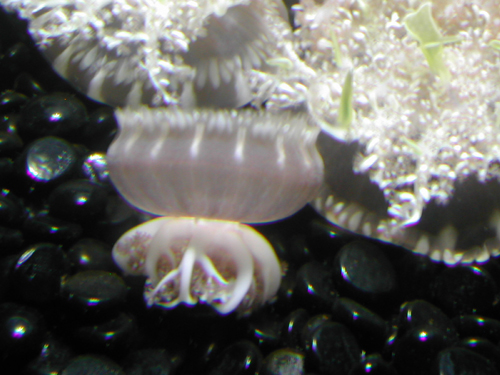
On a recent trip to the Monterey Bay Aquarium I snapped this picture of an underwater garden of the sort you might find in mangrove forests and shallow lagoons along tropical coasts.
It gets some of its food by way of photosynthesis, but not all of it.

Another important source of food for this garden is zooplankton. And indeed, these beautiful flowery organisms depend on algae to perform the photosynthesis for them. Because these aren’t aquatic plants.

They’re “Upside-Down Jellies” (Cassiopeia xamachana). Here, to the left of the jellies who are upside-down and attached to the bottom of the tank with their bells, you can see one that’s right-side-up and unattached. Their green coloration is due to the symbiotic algae.
These fascinating creatures are one more reason to be careful with mangrove forests — losing these forests to development means losing habitat for the Upside-Down Jelly.

So, it’s not just toast that falls with the jelly side down. 😉
That is an outstanding display. MBA has done some incredible work on jellies, and some of their exhibits on them have been just breathtaking.
In the tank of upside-down jellies, I always like looking for the tiniest ones swimming about. Wonderful stuff. I like the way it captures the imagination of the children, not only with the jellies themselves, but with the optical effects of the curved tank. And great lighting.
Not for nothing do they call that gallery “Jellies: Living Art”!
We’ve recently started to see these critters appearing farther north than normal in my area. Inkspot has some pretty pictures and video of some mediterranean blue jellies too.